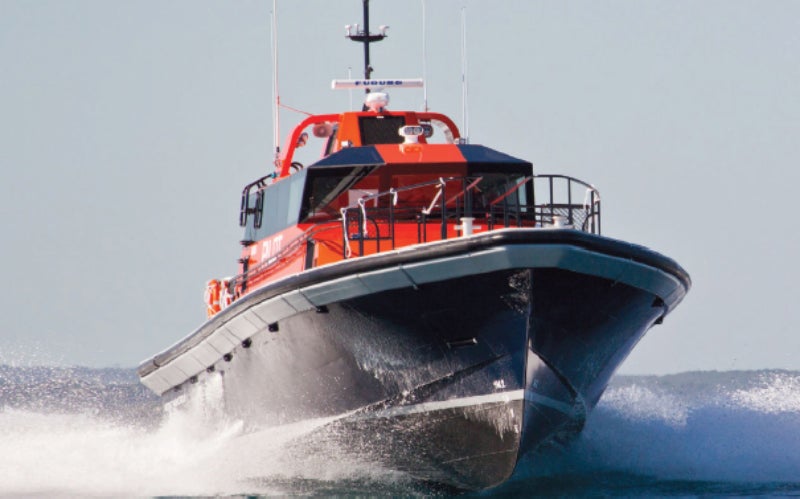
Having seen the successful construction, delivery and operation of the pilot boat Berkeley for the Port of Fremantle in June 2015, Argonaut Marine Group ordered a sistership, named the AMG Winyama, to work out of the Port of Dampier.
Developed to enhance the safety and comfort of marine pilots, the design leverages Southerly Designs’ 40-plus years of experience with high-speed fishing, patrol and offshore crew boats. The design’s ability to safely transfer marine pilots to ships in heavy weather has been proven by Berkeley.
The vessel’s generous waterline length contributes to its seakeeping performance while also improving propulsion efficiency.
Twin keels and full-size pintle-hung rudders provide exceptional directional stability, increased manoeuvrability and roll damping. The stern gear and propellers were supplied by local Western Australia company M&J Engineering. Coupled with the boat’s extra wide side decks and fendering system, these attributes make for a very safe working platform for pilots and crew.
Berkeley operated for more than 3,000 hours in its first year. The heavy workload that pilot boats face is reflected in the specification of proven equipment rated for intensive commercial use. An example is the selection of twin MTU 8V 2000 M72 main engines at MTU’s 1B (heavy-duty) rating.
Southerly Designs founding director John Fitzhardinge explained: “This rating is specifically intended for fast vessels in high load factor applications operating some 5,000 hours per year.
“While some pilot boats use engines rated for yachts and other low load profile applications, we firmly believe the engines and ratings we specify provide end-users with greater long term value and performance as a result of their reliability, extended time between overhaul (TBO) and construction quality.”
Completed by Twin Disc gearboxes and Nakashima propellers, the propulsion package gives AMG Winyama a fully loaded cruising speed of 25.5kt and 29.5kt at 100% MCR.
To deliver AMG Winyama quickly, Niche Marine was contracted to fabricate its robust aluminium hull, which was trucked to Dongara Marine as a bare shell ready for the mechanical installation, fit out and addition of the resin-infused composite wheelhouse. This approach resulted in a build time of just over seven months.
The use of composites results in a lightweight yet durable cabin that is protected against corrosion issues throughout its life. It also provides insulation from the extreme heat that AMG Winyama will experience in the Pilbara.
The wheelhouse is resiliently mounted, further enhancing conditions for those onboard by reducing noise and vibrations to very low levels. Meanwhile, Dongara Marine’s composite construction techniques provide a near superyacht finish inside and out.
Also contributing to providing pilots and crew with a quiet, comfortable work place is Dongara Marine’s high-quality interior fit out. This is evident in features such as padded vinyl linings and the carbon fibre and leather dash. Direct glazed windows provide 360° visibility and are fitted with reflective blinds to reduce heat transfer.
Six Shockwave military specification shock-mitigating seats add to the exceptional ride provided by the Berkeley class hullform, whilst the ergonomic dash enables the skipper to easily access the full array of electronics. These electronics include two Furuno Navnet multi-function plotter, sounder and radar displays with 14.1in glass touchscreens. There is also a third screen at the dedicated pilot position.
Dash clutter is reduced by a customised FinScan IntelliCORE digital switching system that enables the switching for all wheelhouse controlled circuits to occur on a
single 10” (25-centimetre) touchscreen.
Since it is lightweight and resiliently mounted, the wheelhouse can be simply removed if the main engine needs to be taken out. John Fitzhardinge says this feature allows for a more optimal pilot boat design.
He explained: “Whereas some designs have to compromise on the positioning of engines and superstructures to provide for full engine access, our design locates the engines in the best place as far as vessel balance and performance are concerned, while simultaneously positioning the wheelhouse for optimal functionality, visibility, and personnel comfort.”
Argonaut Marine Group managing director Captain Kim Lyons said: “The design provides an amazing ride at speed, especially in heavy weather, and is very dry.”
Meanwhile, Fitzhardinge pointed to the added functionality that the more spacious aft deck and cabin of the Berkeley-class pilot boat provides.
He said: “It enables, for example, a stretcher-borne patient to be easily manoeuvred on the sheltered aft deck and then into the safety and comfort of the cabin, something that is not possible on many pilot vessels.”
Hella Australia lighting used both inside and outside the vessel enables AGM Winyama can perform capably 24 hours a day. The high level of thought that went into the construction, as well as the regard for through-life reliability and maintainability, is evident in the spacious engine room where polished copper-nickel piping is used throughout the seawater system due to its higher corrosion resistance.
Argonaut’s Kim Lyons explained: “The piping, and the choice of man overboard recovery platform, are some of a handful of detail changes Argonaut and Dongara Marine agreed would enhance the original Berkeley design for operation and maintenance in the harsh Pilbara environment.
“To their credit Dongara Marine worked extremely cooperatively to achieve our specific requirements. We would have no hesitation in going back to them for future projects.”
Dongara Marine general manager Rohan Warr said that combining talents was a key to the project’s success.
He said: “To deliver a vessel of the highest standard, Dongara Marine drew not only on our in-house capabilities but also those of specialist contractors who have gained their experience with the hard-working vessels used in the demanding Western Australian rock lobster fishery.
“The contributions of all parties have combined to provide a first-class pilot boat that will provide significantly lower operating and maintenance costs over its lifespan.”

